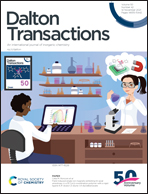Di(hydroperoxy)adamantane adducts: synthesis, characterization and application as oxidizers for the direct esterification of aldehydes†
Abstract
The di(hydroperoxy)adamantane adducts of water (1) and phosphine oxides p-Tol3PO·(HOO)2C(C9H14) (2), o-Tol3PO·(HOO)2C(C9H14) (3), and Cy3PO·(HOO)2C(C9H14) (4), as well as a CH2Cl2 adduct of a phosphole oxide dimer (8), have been created and investigated by multinuclear NMR spectroscopy, and by Raman and IR spectroscopy. The single crystal X-ray structures for 1–4 and 8 are reported. The IR and 31P NMR data are in accordance with strong hydrogen bonding of the di(hydroperoxy)adamantane adducts. The Raman ν(O–O) stretching bands of 1–4 prove that the peroxo groups are present in the solids. Selected di(hydroperoxy)alkane adducts, in combination with AlCl3 as catalyst, have been applied for the direct oxidative esterification of n-nonyl aldehyde, benzaldehyde, p-methylbenzaldehyde, p-bromobenzaldehyde, and o-hydroxybenzaldehyde to the corresponding methyl esters. The esterification takes place in an inert atmosphere, under anhydrous and oxygen-free conditions, within a time frame of 45 minutes to 5 hours at room temperature. Hereby, two oxygen atoms per adduct assembly are active with respect to the quantitative transformation of the aldehyde into the ester.



 Please wait while we load your content...
Please wait while we load your content...